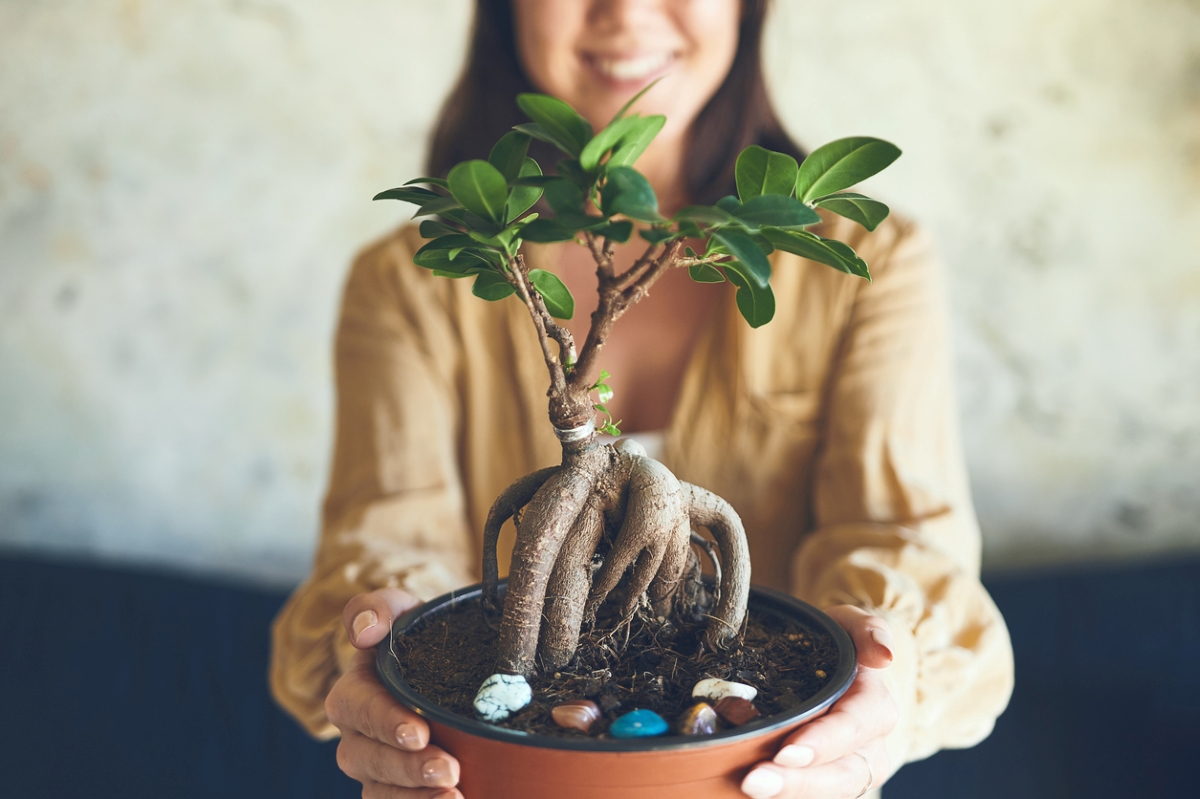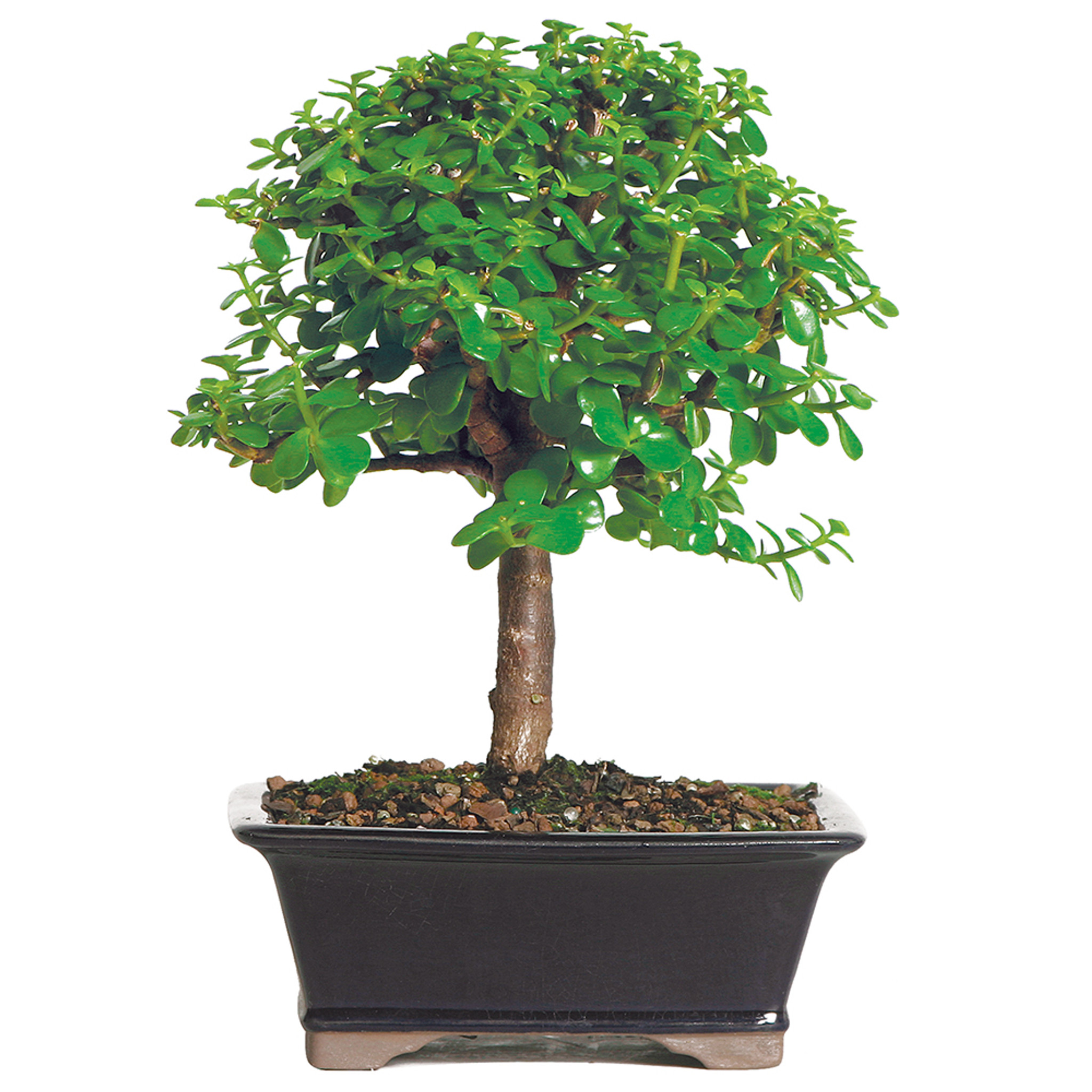

We may earn revenue from the products available on this page and participate in affiliate programs. Learn More ›
Bonsai, a horticultural art that hails from ancient China, endures as a popular hobby and art form. Bonsai refers to the craft of cultivating, shaping, and maintaining trees so they represent both nature and creative expression. To Daniel White, owner of Black River Bonsai in Sheffield Village, Ohio, “growing and caring for bonsai can be a very rewarding and relaxing hobby.” In fact, his company motto is “Cultivate Your Calm.” He offers some advice on selecting and caring for trees based on more than 25 years of experience.
Nearly any tree can become a “bonsai tree,” and selecting a plant—especially for beginners—is similar to selecting any plant to suit your climate or indoor conditions, though some species take better to bonsai design. “I generally recommend beginners choose a species that will be forgiving of novice mistakes,” says White. One of his favorites is Juniperus procumbens ‘Nana’, or dwarf Chinese garden juniper. Below, see a list of trees that experts like White recommend, along with tips for buying bonsai stock and getting off to a good start with a newly purchased bonsai tree.
Choosing a Bonsai Tree

Much like choosing a landscape tree, personal preference and especially climate zone or growing conditions are major considerations when purchasing a tree for bonsai, as is its forgiving nature to beginner pruning. A few other traits can weigh in the decision. “Certain characteristics like appealing bark and branch structure, as well as proportionally small foliage tend to be more appealing,” says White.
Growing conditions should be top of mind. Although some subtropical trees can handle mostly indoor conditions, the majority are better suited to their natural outdoor environment. “They like the sunshine, wind, rain, and fresh air,” says White, so he recommends giving all species outdoor time when conditions are right. Trees from temperate zones are susceptible to freezing and need to be indoors and dormant in winter. White cautions that still other winter-hardy species should remain outdoors in winter, which is part of their natural cycle. So, be sure to compare the care needs and native zone for the species chosen with the conditions in which you plan to keep it. “Many trees have been lost by trying to keep them indoors year-round,” says White.
Also, consider a tree’s age. According to Hal Johnson, president of the Long Island Bonsai Society, “beginners should consider younger trees to learn on since they develop faster and shorten your learning curve.” White also recommends that beginners select relatively young trees Once trees reach 50 years or older, they have specific care requirements. A tree that is 5 to 10 years old “will be more resilient and more economical,” White says. Older trees often come with a high price tag to make up for their years of care.
Setting up Your Bonsai Tree

Bonsai care begins from the moment you acquire your tree and place it in a small pot with drainage that will help restrict root growth and plant size. Once you have cleaned and pruned the roots, prepare the pot with a coarse-grain soil at the bottom, topped by a looser soil that drains well. Knowing specific soil components to add constitutes an art and science in and of itself, so beginners are best served by starting with a commercial soil mix specific to bonsai growing and a training pot rather than looking for the perfect pot to complement the tree, which will take on a shape and personality with time.
White says there are plenty of online resources from local and regional bonsai societies, or available by joining the American Bonsai Society; he serves on the organization’s board.
1. Ficus (Ficus spp.)

Thankfully, some trees—for instance, ficus—thrive in an indoor environment. One of White’s favorite trees for beginners is F. microcarpa, or Chinese Banyan fig. It likes temperatures above 68 degrees Fahrenheit but also needs high humidity. F. microcarpa ‘Ginseng’ is a specific variety often used for bonsai. F. retusa is another ficus type, favored for its visually interesting trunk when grown for bonsai. Those who live in USDA Zones 10 and 11 can leave these ficus bonsai trees outdoors most of the year.
Ficus trees respond positively to growing restrictions. In bonsai, selecting a small container is key to restricting plant size. They’re also forgiving of lapses in watering and other types of care. Just make sure to choose a sunny spot for your bonsai ficus.
2. Japanese Maple (Acer palmatum)

Adored for its color-changing and delicate leaves, the Japanese maple can be trained to create a beautiful bonsai tree. Outdoors, the trees grow best in USDA Zones 5 to 8, and the leaves often remain green in summer in hotter areas. The species is excellent for containers and bonsai, since confining the tree’s roots slows down top growth. Still, smaller species or dwarf types like Kiyohime maple (zones 6 to 9) are likely best for bonsai. Crimson Queen has fern-like leaves that turn bright orange-red in fall.
Although the trees like sun, too much can damage the leaves. It’s best to avoid direct sunlight when temperatures soar to 85 degrees Fahrenheit. Water a Japanese maple bonsai daily during its summer growing season.
RELATED: 115 Trees and Shrubs That Thrive in Containers
3. Chinese Elm (Ulmus parvifolia)

This slow-growing plant is one of White’s choices for beginners to bonsai. Chinese elms are strong trees that react to pruning well, grow slowly, and endure occasional care lapses like too long without water or too much moisture in the soil. This tree can spend time outdoors in most regions and endure light frost, though it will do best indoors in a cool room in winter. As a rule, the trees grow well in USDA Zones 5 to 10.
Pick a spot with lots of bright morning sun that turns shady in the afternoon. Water when the top of the pot’s soil feels dry. The trees are not very susceptible to pest infestations, except for spider mites. But these small insects are typically easy to control with a few applications of neem oil. Although Chinese elm is the most popular of the elm trees for bonsai, the Siberian elm (U. pumila) has larger leaves and interesting bark.
4. Juniper (Juniperus spp.)

This needle-leaved tree looks mighty attractive in miniature form. However, junipers don’t do well indoors, so select one that can remain outside as much of the year as possible. That shouldn’t be too tough, since junipers can handle colder weather than some bonsai options (USDA Zones 4 to 9). Johnson recommends juniper as an outdoor bonsai species for beginners. Place juniper in a spot where they can get at least 4 hours of sun per day.
White notes that Chinese garden juniper (J. procumbens ‘Nana’) is a great pick for beginners. The dwarf conifer can form a dense canopy above twisting branches. As with other beginner-friendly bonsai trees, junipers are pest-resistant. However, spider mites and webworms sometimes target them. Although aggressive pruning can weaken junipers and cause browning, the trees will ultimately recover from pruning mishaps.
5. Brazilian Rain Tree (Chloroleucon tortum)

Among White’s favorite trees for bonsai, this tropical tree “is a little more challenging, but I’ve seen many beginners be successful with it,” he says. The tree forms twisting stems and branches with a gray tint to the wood. Native to Brazil, this stunner needs plenty of light. So, while indoor temperatures suit it, be sure to put it near a window that faces south or place it under grow lights.
When given outdoor time, just be sure to bring the USDA Zone 9 to 11 tree back inside when temperatures are expected to drop to near 45 degrees Fahrenheit. Be aware that this tree has some thorns, but that drawback is offset by its fragrant white puffy flowers that will add scent inside or attract butterflies outdoors.
RELATED: 10 Trees That Tolerate Low Light Indoors
6. Spruce (Picea spp.)

Though a little more challenging for bonsai purposes, spruce trees are large evergreen conifers with whorled branches that are controlled well with wiring. The trees feature compact foliage. Among good options for bonsai are Ezo spruce (P. jezoensis), Norway spruce (P. abies), and Colorado blue spruce (P. pungens). These North American natives are long-lived trees that have medium drought tolerance, silvery-blue foliage, and good cold tolerance.
Colorado blue spruce is particularly cold hardy (USDA Zones 2 to 7), but take some extra care with your bonsai spruce so that roots do not freeze outdoors in winter. Look for a dwarf variety of the tree for best success (like P. pungens ‘Baby Blue’). A bonsai spruce needs full sun during its growing season and partial shade when grown outdoors in a pot. Water often, but do not let the soil remain constantly wet.
7. Cotoneaster (Cotoneaster spp.)

Most types of cotoneaster are shrubs, low-growing evergreens that respond well to pruning. Its small glossy green leaves add to its bonsai appeal. Native to three continents—Asia, Europe, and Africa—cotoneasters also feature small apple-shaped fruits that appear after a bloom of little white flowers. C. frigidus can grow more upright like a tree, and C. microphyllus is another excellent cotoneaster type for bonsai.
To grow cotoneasters, select a spot in full sun outside if possible. Provide frost protection for plants in containers. Most cotoneaster varieties are cold hardy in Zones 4 to 8, but hardiness varies among varieties. In contrast with the more challenging bonsai species, these trees are drought-tolerant as long as the dry periods are short. Additionally, because the branches of cotoneasters are flexible, they take well to shaping via wires.
8. Snow Rose (Serissa japonica or S. foetida)

Also called Japanese boxthorn, Serissa is a subtropical small shrub that flowers with tiny single or double miniature white blooms. The snow rose also has small foliage, so it has great visual appeal as a bonsai tree. A member of the coffee family, the shrub can be evergreen or semi-evergreen. The snow rose is hardy only in USDA Zones 7 to 11, and will need lots of light indoors—in fact, the warmer the indoor air, the more light it requires.
Johnson ranks Serissa as a good indoor species for beginners to bonsai. Although more particular than some bonsai options (moving it to a new location can cause leaves to drop), it recovers well when placed in its favorite conditions.That typically means partial shade outdoors in spring and summer, and an indoor spot on a sunny windowsill or table, or under grow lights indoors. Bring it in once temperatures hover near 50 degrees Fahrenheit outside. Give Serissa plenty of humidity as well, with a humidity tray under the pot when indoors.
9. Desert Rose (Adenium obesum)

This favorite of Southwest gardeners is a small succulent tree from dry regions of Africa and Asia, and grows well in containers. Although it can produce full rose-like flowers, the trunk and crown of the Adenium really stand out when grown with bonsai techniques. It has a swollen or bulbous trunk just above the soil that keeps the plant’s appearance unique, even when the leaves drop in winter.
Less cold hardy than some of the plants on this list, desert rose needs to move indoors when temperatures reach about 55 degrees Fahrenheit; it is hardy only in USDA Zones 11 and 12. Give it plenty of sunlight while inside to promote flowering. Adeniums typically need water only every 7 to 10 days; always let the soil dry between watering. Those with children, pets, or sensitive skin need to know that the plant has high poison severity. Nearly all parts can irritate the skin and cause severe reactions if ingested.
10. Jade (Crassula ovata or Portulacaria afra)

Crassula ovata is the more commonly known jade houseplant, which includes nearly 300 of the succulent types. Portulacaria afra, also known as dwarf jade or baby jade, technically is not a jade, but is a perennial succulent in the purslane family. Both are excellent beginner bonsai species because they don’t need regular watering and grow well indoors. P. afra has smaller fleshy leaves, and is a resilient plant that can endure a few care or pruning mistakes.
To shape portulacaria, avoid wires and stick to careful pruning. Because they grow quickly, regular pruning is necessary to maintain an aesthetically pleasing shape. In Zones 9 to 11, it’s possible to grow baby jade outdoors until nighttime lows hit about 40 degrees Fahrenheit. True jade (C. ovata) is less cold hardy, growing only in zones 11 and 12. To be safe, bring it in even sooner, when temperatures trend toward 50 degrees. Otherwise, their pruning and care needs are similar; just be careful not to overwater, because these plants are susceptible to root rot.
RELATED: The 22 Best Trees to Grow Indoors
11. Rosemary (Salvia rosmarinus)

Make some edible art by choosing a rosemary plant for your bonsai hobby and enjoying its scent and scented silvery foliage. Best of all, when you prune your rosemary bonsai, you’ll not only help maintain the plant’s shape, you’ll also net herbs for dinner. The evergreen herb is vulnerable to root rot, so make sure to keep plants in a pot with sufficient drainage and avoid overwatering. Rosemary typically is hardy in USDA Zones 8 through 10, and the plant will need to come indoors when the weather begins to approach freezing temperatures.
Rosemary enjoys full sun outdoors or in a southern-facing window. To maintain rosemary’s miniature size, remove new growth that appears after the first set of leaves. Trimming at least 25 percent of the roots will help prevent the plant from outgrowing its pot. Shape the branches with wiring as long as they are young and supple enough.
Other herbs amenable to bonsai-growing include:
- Thyme
- Lavender
- Oregano
- Bay laurel
